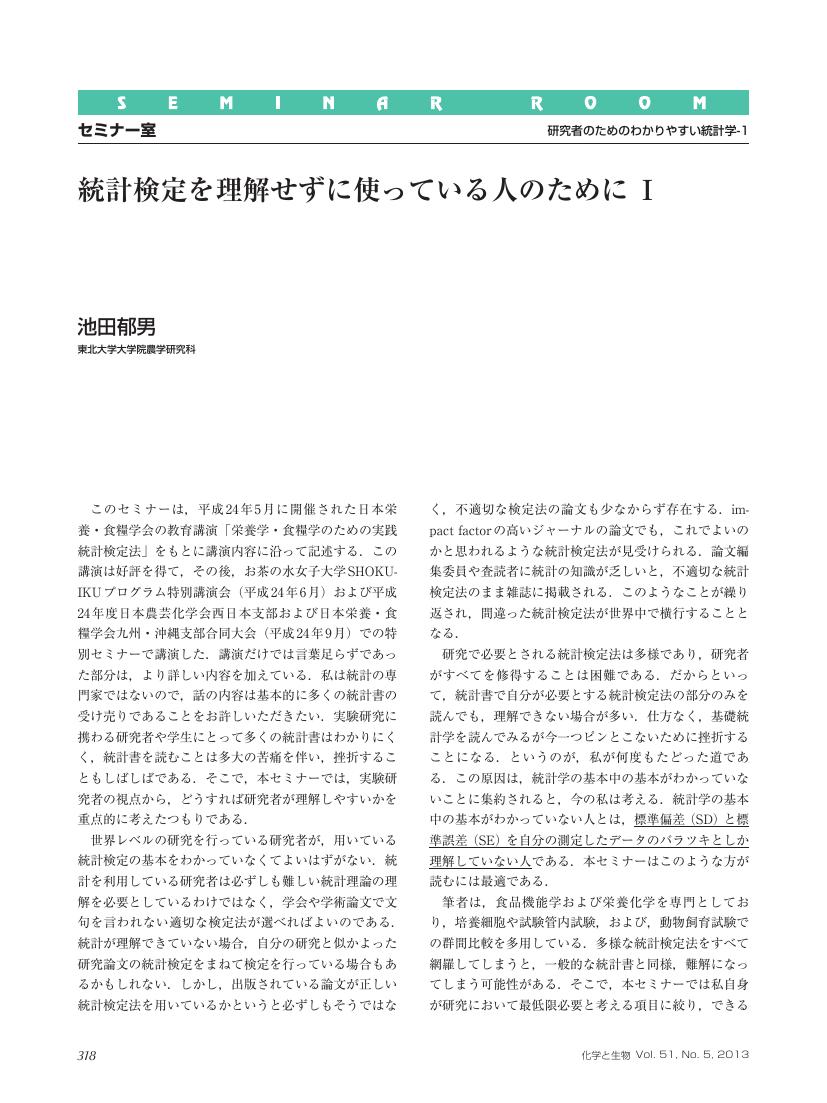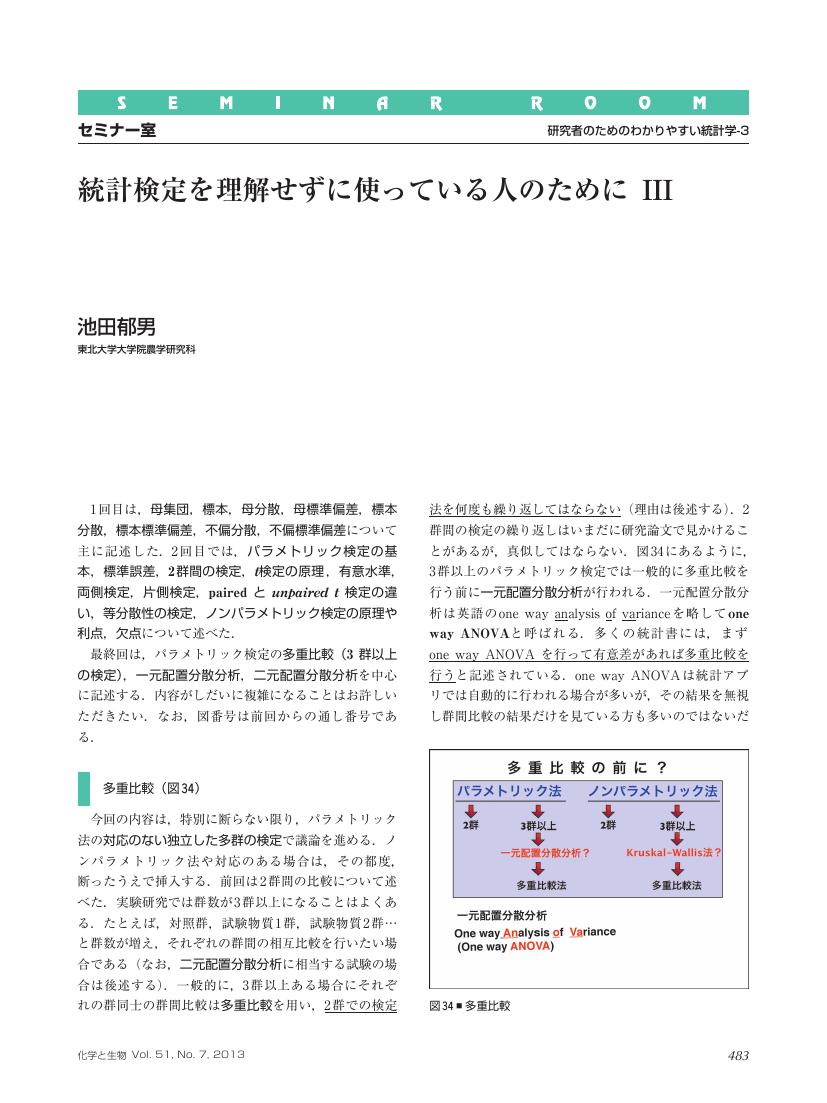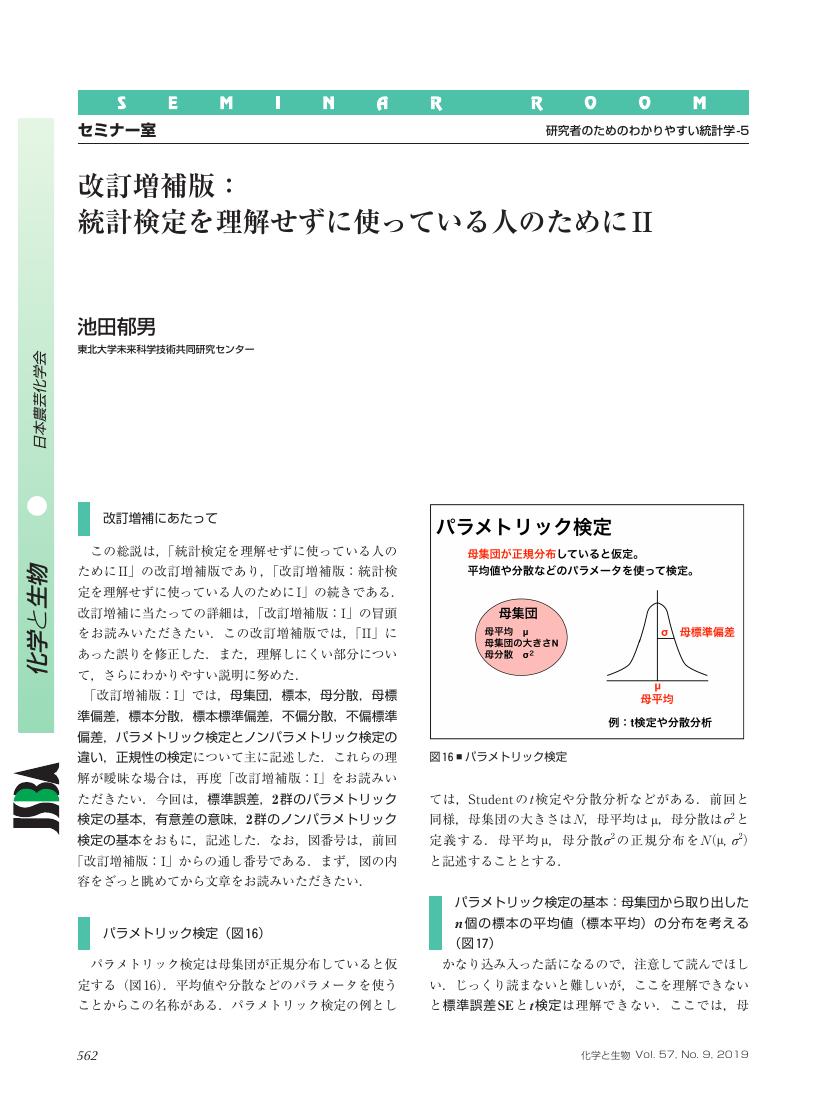1868 0 0 0 OA 統計検定を理解せずに使っている人のために I
- 著者
- 池田 郁男
- 出版者
- 公益社団法人 日本農芸化学会
- 雑誌
- 化学と生物 (ISSN:0453073X)
- 巻号頁・発行日
- vol.51, no.5, pp.318-325, 2013-05-01 (Released:2014-05-01)
- 参考文献数
- 4
- 被引用文献数
- 2 1
1477 0 0 0 OA 統計検定を理解せずに使っている人のために II
- 著者
- 池田 郁男
- 出版者
- 公益社団法人 日本農芸化学会
- 雑誌
- 化学と生物 (ISSN:0453073X)
- 巻号頁・発行日
- vol.51, no.6, pp.408-417, 2013-06-01 (Released:2014-06-01)
- 参考文献数
- 4
- 被引用文献数
- 1 1
1061 0 0 0 OA 統計検定を理解せずに使っている人のために III
- 著者
- 池田 郁男
- 出版者
- 公益社団法人 日本農芸化学会
- 雑誌
- 化学と生物 (ISSN:0453073X)
- 巻号頁・発行日
- vol.51, no.7, pp.483-495, 2013-07-01 (Released:2014-07-01)
- 参考文献数
- 6
- 被引用文献数
- 4
39 0 0 0 OA 改訂増補版:統計検定を理解せずに使っている人のために I
- 著者
- 池田 郁男
- 出版者
- 公益社団法人 日本農芸化学会
- 雑誌
- 化学と生物 (ISSN:0453073X)
- 巻号頁・発行日
- vol.57, no.8, pp.492-502, 2019-08-01 (Released:2020-08-01)
- 参考文献数
- 9
36 0 0 0 OA 改訂増補版:統計検定を理解せずに使っている人のためにII
- 著者
- 池田 郁男
- 出版者
- 公益社団法人 日本農芸化学会
- 雑誌
- 化学と生物 (ISSN:0453073X)
- 巻号頁・発行日
- vol.57, no.9, pp.562-579, 2019-09-01 (Released:2020-09-01)
- 参考文献数
- 6
12 0 0 0 OA 改訂増補版:統計検定を理解せずに使っている人のためにIII
- 著者
- 池田 郁男
- 出版者
- 公益社団法人 日本農芸化学会
- 雑誌
- 化学と生物 (ISSN:0453073X)
- 巻号頁・発行日
- vol.57, no.10, pp.629-647, 2019-10-01 (Released:2020-10-01)
- 参考文献数
- 6
- 被引用文献数
- 1 2
2 0 0 0 統計検定を理解せずに使っている人のためにI
- 著者
- 池田 郁男
- 出版者
- Japan Society for Bioscience, Biotechnology, and Agrochemistry
- 雑誌
- 化学と生物 (ISSN:0453073X)
- 巻号頁・発行日
- vol.51, no.5, pp.318-325, 2013-05-01
- 被引用文献数
- 1
1 0 0 0 統計検定を理解せずに使っている人のために III
- 著者
- 池田 郁男
- 出版者
- 公益社団法人 日本農芸化学会
- 雑誌
- 化学と生物 (ISSN:0453073X)
- 巻号頁・発行日
- vol.51, no.7, pp.483-495, 2013-07-01
- 参考文献数
- 6
- 被引用文献数
- 4
1 0 0 0 OA 共役リノール酸の食品中の含量と生理機能
- 著者
- 河原 聡 田丸 靜香 窄野 昌信 福田 亘博 池田 郁男
- 出版者
- The Japanese Society of Nutrition and Dietetics
- 雑誌
- 栄養学雑誌 (ISSN:00215147)
- 巻号頁・発行日
- vol.62, no.1, pp.1-7, 2004-02-01 (Released:2010-02-09)
- 参考文献数
- 33
Conjugated linoleic acid (CLA) is the collective name for a group of geometric and positional isomers of octadecadienoic acid (18: 2) with conjugated double bonds. Interest in CLA has increased in the past decade as a result of its potential beneficial health effects on experimental animals. We summarize in this review the occurrence in food, biological effects and typical human consumption of CLA. We also review the efficacy and some problems of CLA supplementation as a weight loss agent, and the findings from animal studies and in vitro studies. Since CLA is biologically produced by the rumen bacteria of ruminant animals, ruminant meat and milk contain relatively higher amounts of CLA. The predominant isomers in those foods are 9-cis, 11-trans CLA. On the other hand, chemically synthesized CLA products which are commercially available in the US generally contain equal amounts of 9-cis, 11-trans and 10-trans, 12-cis CLA. The CLA isomers have been shown in animal models to protect against chemically induced cancer and atherosclerosis, and to reduce body fat. Although CLA appears to reduce fat mass in rodents such as mice and rats, we need more evidence to clarify the fat-reducing effect and safety of CLA in humans.
1 0 0 0 OA トランス脂肪酸に関する最近の話題
- 著者
- 永田 純一 池田 郁男
- 出版者
- The Japanese Society of Nutrition and Dietetics
- 雑誌
- 栄養学雑誌 (ISSN:00215147)
- 巻号頁・発行日
- vol.64, no.2, pp.69-76, 2006-04-01 (Released:2010-02-09)
- 参考文献数
- 37
- 被引用文献数
- 1
Trans fatty acids (TFAs) are positional isomers of cis fatty acids. TFAs are mainly produced by partial hydrogenation of unsaturated fatty acids and widely found in a variety of foods, including margarine, shortening and frying oil. A small amount of TFAs is also found in ruminant fats and milk. The amount of TFA intake in Western Europe and North America probably ranges from 5 to 15g/day. Epidemiological studies have shown that an excessive consumption of TFAs raised the LDL-cholesterol level and lowered HDL-cholesterol in humans. A high intake of TFAs is therefore thought to be a risk factor of coronary heart disease. On the basis of scientific evidence, the U. S. FDA required labeling of the TFA content for conventional food and dietary supplements on January 1, 2006. TFAs are also restricted their uses in the EU. The TFA intake in Japan is estimated to be approximately 1.6g/day, this amount being markedly lower than that in western countries. Although the low TFA intake in Japan is not thought to be an important issue at present, we should pay attention to an excessive intake of TFAs in the future.
1 0 0 0 OA 日本人の共役リノール酸摂取量に関する考察
- 著者
- 本間 太郎 佐藤 謙太 篠原 菜穂子 伊藤 隼哉 荒井 達也 木島 遼 菅原 草子 治部 祐里 川上 祐生 野坂 直久 青山 敏明 都築 毅 池田 郁男
- 出版者
- 公益社団法人 日本食品科学工学会
- 雑誌
- 日本食品科学工学会誌 (ISSN:1341027X)
- 巻号頁・発行日
- vol.59, no.2, pp.63-68, 2012-02-15 (Released:2012-03-28)
- 参考文献数
- 31
- 被引用文献数
- 4 5
CLAは抗肥満作用,抗がん作用など,多彩な生理機能を持つことが知られており,サプリメントとして市販されているが,日本人において摂取量や吸収代謝に関する報告はほとんどない.本研究では,日本人のCLA摂取における知見を得るため,日本人のCLAの日常的な摂取量,日常的な血中CLA濃度,CLAサプリメント摂取時の血中CLA濃度の変化について検討した.その結果,日本人は日常的に食事から37.5 mg/日のCLAを摂取していることが明らかとなった.また,日本人の日常的な血中CLA濃度は血漿中で6.4μmol/L,血球中で1.7μmol/Lであった.さらに,1日2.3gのCLAサプリメントを3週間摂取することで,血中CLA濃度は血漿中で7.7倍,血球中で8.7倍に増加した.外国人の報告と比べると,日本人は日常的なCLA摂取量や血中CLA濃度は少ないが,CLAサプリメントを摂取することでその濃度は飛躍的に上昇することが明らかとなった.以上より,日本人は1日2.3gのCLAサプリメントを長期摂取することで有益な生理作用を得ることができると考えられた.
- 著者
- 池田 郁男
- 出版者
- 日本農芸化学会 ; 1962-
- 雑誌
- 化学と生物 : 日本農芸化学会会誌 : 生命・食・環境 (ISSN:0453073X)
- 巻号頁・発行日
- vol.57, no.8, pp.492-502, 2019-08
1 0 0 0 OA クロナマコのラット血清および肝臓脂質濃度に及ぼす影響
- 著者
- 田中 一成 西園 祥子 加瀬 綾子 巨椋 澄子 栗田 翠 村上 智子 久木野 憲司 松本 仁 池田 郁男
- 出版者
- 公益社団法人 日本栄養・食糧学会
- 雑誌
- 日本栄養・食糧学会誌 (ISSN:02873516)
- 巻号頁・発行日
- vol.56, no.3, pp.175-179, 2003-06-10 (Released:2009-12-10)
- 参考文献数
- 21
- 被引用文献数
- 9 10
一般に食用とされていないクロナマコの有効利用を図ることを目的として, クロナマコ摂取がラットの脂質代謝に及ぼす影響を検討した。生のクロナマコの可食部をフードカッターで粉砕し, 凍結乾燥後粉末状にしたものを試料としてラットの餌を調製した。タンパク質レベルを20%とし, クロナマコを用いた食餌ではタンパク質源としてカゼインとクロナマコを窒素含量で3:1の割合にした。対照として, タンパク質源にカゼインのみを用いたコントロール群を設けた。コレステロール (Chol) を0.2%添加したこれら飼料をSD系雄ラットに4週間自由摂食させた。クロナマコは血清および肝臓Chol濃度をコントロール群より有意に低下させ, HDL-Chol/総Chol比を上昇させた。クロナマコ摂取ラットで糞中への中性および酸性ステロイド排泄は促進した。これらの結果より, クロナマコは糞中へのステロイド排泄促進によりChol低下作用を発現することが明らかとなった。






